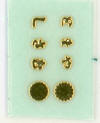|
|
|
The Pontos Yamato
As can be expected, due to her elevated status, Yamato has been offered
many times in kit form, most recently with offerings from both Fujimi and Pit
Road (the latter being the previously acknowledged standard for Yamato kits). Pontos Models, who've been a well-known and long-time producer of high quality
multi-media upgrade sets, has followed in the steps of Flyhawk models and
released their first injection molded kit, choosing the 1945 Yamato as
their first subject.
The model comes in a large, glossy white box with a very
nice drawing of the ship on the cover. The entire box (including the
sides of the bottom half) is covered in computer generated renders of the
model. Inside the box are six injection molded sprues, an injection molded
display stand and associated parts for the stand, over 200 turned brass parts, 5
frets of photo-etch, a wood deck, decals and flags. There is also an
instruction booklet, and two different pieces of artwork depicting Yamato,
including that duplicates the box art. |
|
|
| THE HULL
(SPRUE A) |
|
|
The hull appears to scale out pretty much perfectly in
length and beam. It's a two piece affair - split in halves - that's
well molded in light gray plastic, with some of the nicest hull plating I've
ever seen. It's there, you can see it, but it's not overstated.
There are openings in the lower hull (to be covered by photo-etch) for the sea
chests. Some of the chocks are molded integral to the hull halves.
Inside the hull is a groove along the waterline, for those wishing to cut the
hull down to a waterline version. The sprues are also labeled "1/700
Yamato/Musashi", so that seems to indicate at least one more version of this
class is coming.
|
|
|
| SPRUE B |
|
|
On this sprue, you'll find decks, struts, shafts,
rudders and hull stiffeners Like the hull itself, the stiffeners
have a groove to allow them to be cut down to the waterline. Also included
is the very tip of the bow and the very tip of the stern, with chocks molded
into the parts. The way this kit is designed with wood and
photo-etch decks, all the decks have zero detail on them.
|
|
|
| SPRUE C |
|
|
The large central superstructure is prominent on this
sprue, along with the parts for the tower bridge, funnel, the bases for the 6"
secondary weapons as well as various other superstructure parts.
Much of the detail on this kit will be added via photo-etch, but what's molded
on looks good. |
|
|
| SPRUE D |
|
|
The large superstructure sections for the ships extensive AA armament are
included on this sprue, along with various gun tubs and other AA related parts. |
|
|
| SPRUE E (X2) |
|
|
There are two of these sprues in the kit. Here you'll find the main
and secondary battery turrets (4 of each), along with their respective blast
bags. There are the open and closed AA gun batteries, props, range
finders, a boat and the "sandbag" shields that protected the AA guns on the
deck. There is some nice detail on the turrets and what looks like small
locator holes molded into parts, to accommodate the photo-etch. As
with some of the parts on the other sprues, there are also parts are devoid of
detail, due to the extensive amount of photo-etch included. |
|
|
| DISPLAY BASE |
|
|
A display base,
with finials and mounting hardware is included in the model. |
|
|
| DECALS AND
MARKINGS |
|
|
The kit comes with multiple decals and markings.
There are waterslide decals, printed by Cartograf, dry-transfers printed by
Hobbydecal, a small decal sheet with the ships names and chrysanthemum, along
with paper flags. The waterslide decals include mostly
markings for the aircraft, and look to be perhaps a bit on the thick side.
The dry-transfers have mostly draught markings, but also alternate decals for
the emblem carried on either side of Yamato's funnel. |
|
|
| WOOD DECK |
|
|
The wood deck is usual Pontos quality and looks good
It's designed to fit into the plastic deck, which is recessed so that the wood
deck will be flush with the sides of the hull. This is unlike aftermarket
decks, whose edges will rise above the sides of the hull and deck fittings.
My only other comment would be that while the wooden deck is left natural wood,
since this is a 1945 version of Yamato, it should be stained, like
Yamato's were at the time of her loss. |
|
|
| TURNED BRASS
PARTS |
|
|
There are 229 turned brass parts included in this kit!!
Among the plethora of parts are: gun barrels for the main, secondary, open
and closed AA guns; bitts; range finders; davits; masts; yards; the base for the
crane and more. Everything looks well done. There's also a
blackened anchor chain included. |
|
|
| PHOTOETCH |
|
|
The Pontos Yamato is a photo-etch intensive
kit. There a four large frets of photo-etch and one very small
"addendum" fret. You'll find many, many, many, very, very, very
small PE pieces on these frets, which Pontos labels as "sheets".
Overall, as you may expect from a company that specialized in aftermarket
upgrade sets, the quality is very good.
SHEET S
This fret, which is the largest in the kit, appears to be made of stainless
steel. On it, you'll find the foredeck, well deck, aircraft handling deck,
name plates (in both English and Japanese), railings and assorted other
platforms. Also, you'll find templates to be used to drill portholes
specific to this version of the ship.
SHEET T
The is the smallest of the main sheets. On it are hatches, decking,
vertical and inclined ladders, vents, W/T doors and more. Lots of
relief etched parts.
SHEET U
Here are the catapults, wings for the floatplanes, cranes, "faces" for the
searchlights, davits, details for the rudders, platforms and more.
As mentioned, there is a small "U addition" fret which has what looks like
rigging for a crane, or something similar.
SHEET V
On this fret there are AA platforms, lot and lots of parts for AA guns, more
vents, more railings, details for the main battery turret range finders and
more. |
|
|
|
|
| INSTRUCTIONS |
|
|
The instructions are in booklet form - 32 pages, printed
on glossy paper. The first 5 pages cover the parts manifest before getting
into the actual construction, which is basically a series of sub assemblies.
The instructions seem logical to follow, but there are lots of diagrams and lots
and lots of parts, so take your time and follow them closely. That may be
heresy for most modelers, but with the complexity of this kit, probably
warranted.
|
|
|
| ARTWORK |
|
|
Included in the box are two pieces of artwork. One
folds out to reveal a profile rendering of Yamato. The other is
rolled, and has multiple renderings of Yamato on one side, and a duplicate of
the box art on the other side.
|
|
|
| CONCLUSIONS |
|
Pontos has certainly entered the
injection-molded kit arena with a bang. They've taken an interesting
and somewhat innovative approach, with wood and photo-etch upgrade parts being
used in lieu of traditional injection-molded detail. Overall, I
think this is a good looking kit of this famous Japanese battleship, one which
should make IJN aficionados and "Yamato-philes" very happy. It also
appears that we will get future releases out of these molds as well.
This is Pontos Models 1/700 Yamato 1945, kit number 70002R1. The model lists for
$149.95, and is available from
FreeTime Hobbies - who I'd like to thank for this
review sample. Considering all the photo-etch included in the box, I
think that's actually a very fair price. My only nit-pick is the
natural wood deck included for the 1945 version. This kit is highly recommended, with
one (big) caveat: with the prodigious amount of photo-etch included to
bring out the details, this kit is
NOT for beginners.
This is an in-box
review, and while everything looks great in the box, your mileage may vary, once you commence construction. |
 |


















